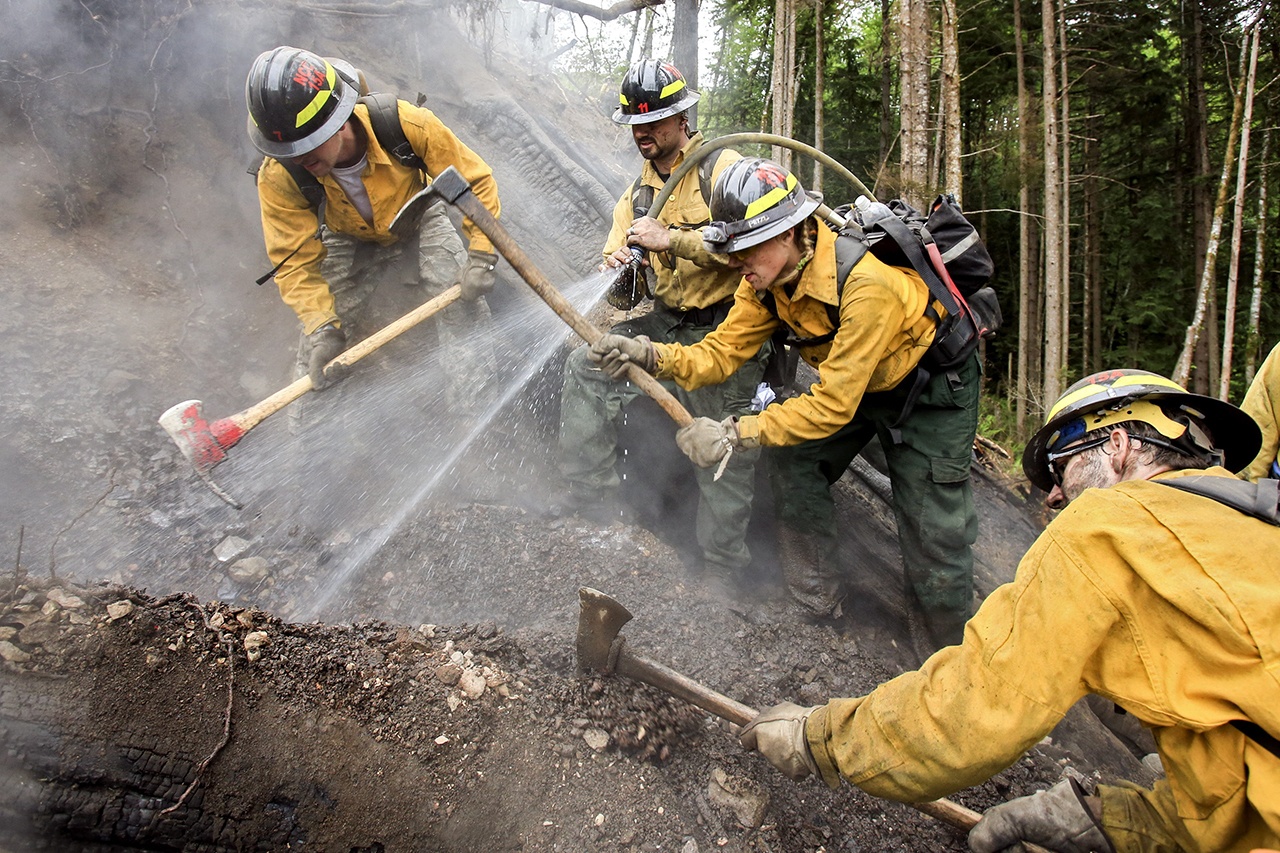EVERETT — The first time Snohomish County used a state law to send firefighters to a blaze in Eastern Washington, it was 1994.
Travis Hots remembers. He was 18, a volunteer from Lake Goodwin.
He didn’t know he had to bring his own tent or protective gear. He was issued a paper sleeping bag when he got to Leavenworth.
In 2015, Snohomish County firefighters went to 17 major wildfires statewide. Already this year, they’ve seen blazes here, in Oso and Gold Bar. Last year, a small wildfire in a ravine just outside of Everett burned for days and endangered homes.
“People are realizing it might be a threat here,” said Heather Chadwick, a spokeswoman for the Clearview and Monroe fire districts.
In recent years, more local fire departments have been adding wildfire training, equipment and rigs. They say that with changing weather patterns, like last year’s dry spell, and with development pushing into formerly rural areas, it’s only going to get worse.
Only a few local fire departments used to keep brush trucks, the little firefighting pickups that look like rolling toolboxes.
Now, there are at least 17 of those trucks in Snohomish County, and the number is growing. During wildfires east of the mountains, the fire chiefs all talk to make sure they keep enough resources at home. It’s just part of the equation now.
The Eastern Washington wildfires have turned out to be “tremendous” training opportunities, not just for crews to see big flames but also to get them used to the mechanisms of a major emergency or disaster, Hots said.
And firefighters bring those skills back home. After that experience, a one-acre brush fire doesn’t seem so exciting.
Since 1994, “it’s really evolved and developed,” he said.
Hots is the fire chief for the Getchell and Arlington Rural departments. He also serves as the county-wide coordinator for wildfire response and as a strike team leader.
Gold Bar Fire Chief Eric Andrews oversees statewide wildfire response from this five-county region.
Andrews was among the Snohomish County fire chiefs who pushed to expand the statewide fire mobilization process — which also allows for reimbursement — to cover other kinds of emergencies after the Oso mudslide.
The new thinking about wildfires isn’t unique to rural chiefs. A recent federal grant for urban south county means that every firefighter in Fire District 1, Lynnwood and Mukilteo is expected to undergo wildfire training in the coming months.
That shift in recent years has not been without criticism. When the Proctor Creek wildfire broke out in Gold Bar in May, some Skykomish Valley locals wanted to know why their fire trucks were in Oso at the time, at the Hotshot wildfire, Andrews said. He’s fielded the same kind of questions about sending crews east.
“You’re helping people out and learning,” he said. “People aren’t going to come help you if you don’t go help them.”
It also is a boon to smaller departments in recruiting volunteer firefighters if they can offer those opportunities, Andrews said. That’s partly why they’re seeing more agencies getting involved or re-involved, especially in the past five years.
“That’s a morale booster,” Hots said. “It’s a lure into our organization.”
The county’s Department of Emergency Management also has been paying more attention to wildfires statewide since at least 2012, Director Jason Biermann said. In major incidents here, including the Oso mudslide, the county has seen help arrive from departments in wildfire-prone areas.
In Eastern Washington wildfires, Snohomish County emergency management teams have helped with issuing evacuation orders, or working with the National Guard to organize roadblocks, Biermann said. That’s likely going to happen more in the future from the emergency management standpoint, and the idea is to “support each other back and forth,” he said.
Fire folks get together every year to talk about the coming season and what to expect. The population growth doesn’t just mean additional houses, but cabins, campfires and garbage, Hots said. “More people do more things,” and all of that creates fire risk.
That’s why local firefighters have been launching new public education campaigns, such as Gold Bar’s billboards for “Defensible space?” and “Got your 100 feet?” in which homeowners are encouraged to consider wildfire prevention in their landscaping and maintenance.
During last year’s fire season, Andrews got calls every day asking if Snohomish County could send more crews and rigs to Eastern Washington.
Last year also was the first time in recent memory that firefighters from Lynnwood and Arlington went over Stevens Pass to help with wildfires. The federal grant in southwest county, for $360,000, came after last year saw a number of small local wildfires and freeway brush fires, Lynnwood Fire Chief Scott Cockrum said. Arlington is using community donations to increase wildfire training for nearly every firefighter and to add a brush truck.
Last year, Sultan crews went to a wildfire in Newhalem, on the west side, in the North Cascades. They rode along with another local department to Eastern Washington multiple times, but unlike the Newhalem fire, kept the Sultan brush truck and other rigs at home.
“I didn’t feel like we should spare any apparatus,” Sultan Fire Chief Merlin Halverson said. “We now have an extra brush truck. One of the reasons we bought another brush truck is we’re concerned those Eastern Washington wildfires are going to move over here.”
Every fire season, Hots gets asked about the predictability of wildfires in Snohomish County and elsewhere.
His answer: “I’ll let you know around Halloween.”
Rikki King: 425-339-3449; rking@heraldnet.com.
For more information about wildfire prevention at home, visit www.firewise.org. Snohomish County also has a site, www.snohomishcountywa.gov/3629/Wildfire-Preparedness.
To schedule a risk assessment in or near the Gold Bar fire district, contact scoulson@snofire26.org. For other parts of the county, contact your local fire district.
Talk to us
> Give us your news tips.
> Send us a letter to the editor.
> More Herald contact information.

























